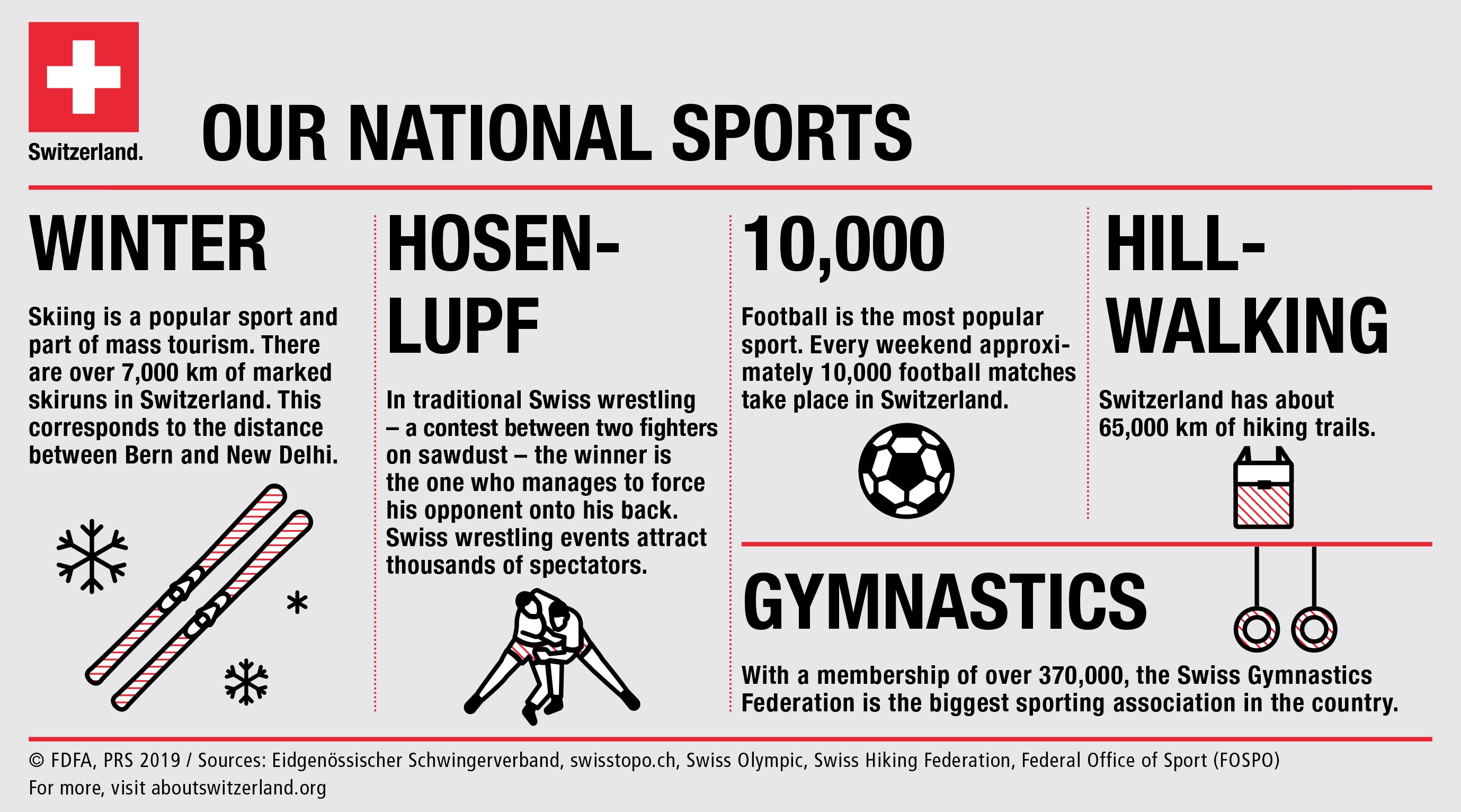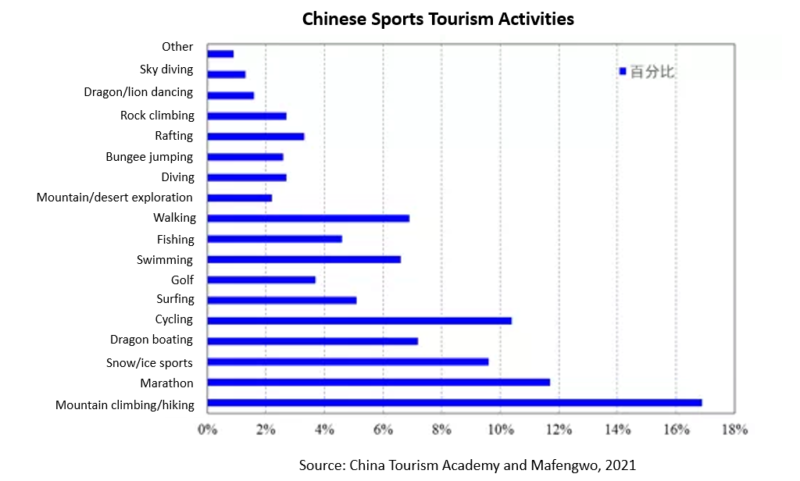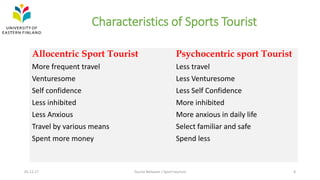Where is Sport Tourism Most Popular?
Sport tourism is most popular in Europe and North America. The increasing interest in both sports and travel has led to a growth in this niche segment of tourism.
Sporting events, facilities and attractions are attracting tourists from all over the world. From spectator sports to active participation and adventure sports, sport tourism offers a range of experiences, from amateur to professional level. This type of tourism generates enormous economic benefits for host countries and cities, creates job opportunities, and promotes cultural exchange and understanding.
Sport tourism is an exciting and dynamic area of travel that caters to a diverse range of interests and preferences, from football fans to adventure seekers.

Credit: www.jkgeography.com
Popular Destinations For Sport Tourism
If you are a sports enthusiast and love to explore different destinations while participating in your favorite sports, the world has a lot to offer. Sport tourism has gained popularity in recent years, and people from different parts of the world travel to various destinations to indulge in sports and adventure activities.
North America
North America is a hub for various sports and attracts a significant number of sports enthusiasts every year. The United States and Canada are the leading destinations in this region, offering plenty of opportunities for adventure activities such as hiking, skiing, snowboarding, and water sports. The North American cities famous for sports tourism include New York, Denver, Las Vegas, and many more.
Europe
Europe is another popular destination for sports enthusiasts who are looking for a mix of sports and adventure activities, combined with history, culture, and breathtaking landscapes. The region offers sports like skiing, mountaineering, cycling, hiking, golfing, and many more. Some of the famous destinations are France, Switzerland, Italy, and Spain.
Asia Pacific
The Asia Pacific region is another popular destination for sport tourism. The region has a lot to offer to sports enthusiasts, ranging from snow activities in Japan to Adventure Sports in Thailand or surfing in Bali. Some of the popular sport tourism destinations in Asia include Hong Kong, Singapore, and Japan.
South America
South America is the best place for adventure and sports activities with its picturesque destinations, cultural richness, and local cuisine. Some of the popular sports activities in this region include soccer, mountaineering, kayaking, and surfing. Some of the popular destinations in South America include Brazil, Argentina, and Chile.
Africa
Africa offers a unique range of sports activities ranging from safaris, mountaineering, trekking, and beach sports. The region has several sports tourism destinations such as South Africa, Kenya, and Tanzania, offering thrilling sports activities combined with breathtaking landscapes, wildlife, and rich culture.
With diverse landscapes and thrilling activities, these popular sport tourism destinations cater to the needs of all sports enthusiasts worldwide.

Credit: www.eda.admin.ch
Factors That Make A Destination Popular For Sport Tourism
Sport tourism destinations are most popular in places that offer a unique experience for visitors. Destinations with well-established sporting events, world-class facilities and scenic surroundings can draw in large crowds. Additionally, factors such as accessibility and affordability can also contribute to the popularity of a sport tourism destination.
Factors That Make a Destination Popular for Sport Tourism Sport tourism has become a popular concept where people are interested in traveling to spectator sports events or participating in various sports activities. With more enthusiasm towards sports, the need for travel to explore different destinations for sports has increased. But, what makes a destination popular for sport tourism? Below are some of the factors that make a destination popular for sport tourism. H3 heading: Weather Conditions Weather conditions play a crucial role in making a destination popular for sport tourism. People prefer to pick destinations that have favorable weather conditions for their preferred sports activities. For instance, skiing is a popular sport that requires cold weather, so destinations like Switzerland, Norway, and Canada are favorable for skiing. Similarly, destinations like Hawaii, Brazil, and Indonesia are preferred for surfing, which requires warm weather. H3 heading: Availability of Sports Facilities The availability of high-quality sports facilities is another vital factor that makes a destination popular for sport tourism. People prefer to travel to destinations that have the best sports facilities that cater to their preferred sports activities. For instance, Dubai has some of the world-class golf clubs that attract golfers worldwide. Also, basketball enthusiasts travel to The United States to watch NBA games or participate in various basketball programs organized by the Basketball Hall of Fame. H3 heading: Accessibility Accessibility of a destination has a significant impact on making it popular for sport tourism. People prefer to select destinations that are easy to reach and have affordable transportation options. Destinations like London, Tokyo, and Sydney have become popular for sports tourism because of their accessible transportation systems, which includes local buses, trains, and internal flights. H3 heading: Local Cultural Attractions Apart from sports facilities, tourists also look forward to experiencing the local cultural attractions of the destination. Destinations like Rio de Janeiro, Cape Town, and Barcelona offer tourists an opportunity to experience cultural and historical attractions, along with sports activities. This is why these destinations have become popular among sports enthusiasts as they offer a complete package of sports and cultural tourism. H3 heading: Safety and Security Safety and security are critical factors that tourists consider while selecting a destination for sport tourism. Tourists prefer to travel to destinations that have a good reputation for safety and security. Destinations like Switzerland, Japan, and Canada have low crime rates, which make them popular among tourists who prefer to enjoy their sports activities in a safe and secure environment. In conclusion, the popularity of a destination for sport tourism depends on various factors. Weather conditions, availability of sports facilities, accessibility of the destination, local cultural attractions, safety, and security are some of the essential factors that attract tourists to select particular destinations for sports tourism. So, if you are planning to travel for sports tourism, you should consider these factors to choose a destination that suits your interests and preferences.Most Popular Sports For Tourists
Sports tourism is most popular in destinations all across the globe. Some of the most common sports that tourists travel to experience include football, basketball, and volleyball. These sports provide a great way to interact with locals and immerse oneself in local culture.
Sports tourism is a rapidly growing industry, with millions of travelers around the world seeking out destinations where they can watch or participate in sporting events. In this blog, we will highlight the most popular sports for tourists and the top destinations where these sports are played.Football/soccer
Football, or soccer, is the most popular sport in the world, and it is no surprise that it is also the most popular sport for tourists. From the Premier League in England to La Liga in Spain, there are plenty of top-tier football leagues that attract fans from around the globe. When it comes to international tournaments, the FIFA World Cup is the biggest event on the sporting calendar, with millions of fans traveling to host countries every four years to watch their national teams compete.Basketball
Basketball is another popular sport for tourists, especially in the United States. The NBA is one of the most watched leagues in the world, and fans from all over flock to cities like Los Angeles, New York, and Chicago to see their favorite teams play. For international basketball, the FIBA World Cup is the premier tournament, with teams from around the world competing for the title every four years.Tennis
Tennis is a sport that has a global fan base, with major tournaments like Wimbledon, the US Open, and the French Open drawing crowds from around the world. Many of these tournaments take place in major cities, such as London, New York, and Paris, making them popular travel destinations for tennis fans.Golf
Golf is a popular sport for tourists who are looking to combine leisure and travel. Some of the top destinations for golf tourism include Scotland, Ireland, and California, where players can enjoy world-class courses while taking in beautiful scenery. The major golf tournaments, such as the Masters and the US Open, also attract thousands of fans from around the world.Cricket
Cricket is a sport that is especially popular in countries like India, England, and Australia. The Indian Premier League, the Ashes, and the Cricket World Cup are major international tournaments that draw large crowds. If you’re a cricket fan, consider traveling to India or Australia to watch a match and experience the unique atmosphere of cricket stadiums in these countries. In conclusion, sports tourism is a burgeoning industry, and there are plenty of opportunities around the world for travelers to watch or participate in their favorite sports. Whether you’re a fan of football, basketball, tennis, golf, or cricket, there are top-tier events and destinations waiting for you to explore.
Credit: www.alamy.com
Benefits Of Sport Tourism For Destinations
Sport tourism is most popular in countries such as Australia, Canada, and the United States. The benefits of sport tourism for destinations include increased tourism revenue, local economic growth, and improved infrastructure. Locals and visitors alike enjoy sporting events, making sport tourism a valuable sector for many destinations.
Sport tourism is a rapidly growing sector of the global tourism industry. Travellers are not just looking for a relaxing holiday but also want to engage in exciting sports activities. Sports tourism is popular worldwide, and destinations that invest in sports tourism can reap the following benefits:Increased Revenue
Sport tourism can generate significant revenue for a destination. The sporting events bring visitors to a destination who spend money on accommodation, food, transport, and local attractions. The revenue generated from sports tourism is not affected by seasonal tourism because sports events typically take place throughout the year.Boosted Local Economy
Sports tourism can also help boost the local economy of a destination. The influx of tourists creates job opportunities for locals in the accommodation, transport, and hospitality sectors. This investment in local businesses leads to an increase in tax revenue, which can be used to improve the infrastructure of the destination.Improved Infrastructure
Sport tourism can help improve a destination’s infrastructure. The development of sports facilities and accommodations can lead to increased investment in transport networks, roads, and other essential infrastructure. This development can also benefit the local community by providing them with access to these facilities and creating new employment opportunities.Enhanced International Reputation
Sport tourism can improve the international reputation of a destination. Hosting international sporting events can increase the exposure of the destination, leading to more opportunities for future events and a greater number of visitors. This exposure can also help attract foreign investment, create new networks, and boost trade in the region.Creation Of Jobs
The creation of jobs is an essential benefit of sport tourism for destinations. The sporting events create jobs in different sectors like hospitality, transport, and event management. Sport tourism can also provide young people with valuable training and employment opportunities, leading to a skilled workforce and economic growth. In conclusion, sport tourism provides destinations with numerous benefits, including increased revenue, boosted local economy, improved infrastructure, enhanced international reputation, and the creation of jobs. By investing in sports tourism, destinations can attract more visitors, generate significant revenue, and improve the overall quality of life for local communities.Sustainable Sport Tourism Practices
Sustainable sport tourism practices are gaining popularity worldwide, with the most popular destinations being those that offer both sport and natural beauty. Destinations such as Hawaii, Costa Rica, and New Zealand combine adventure sports with eco-friendly practices to create an unforgettable experience for travelers who care about the environment.
Sustainable sport tourism practices are gaining momentum worldwide, and for a good reason. These practices are focused on promoting and developing a balanced relationship between sports, tourism, and the environment. Sustainable sport tourism practices aim to ensure that the development of sports activities does not deteriorate the local cultural and natural heritage of a destination. In this section, we will discuss the various sustainable sport tourism practices employed globally.Reduced Carbon Footprint
Reducing the carbon footprint of sport tourism activities has become a top priority for various stakeholders in the tourism industry. Sports events like marathons and cycling races can have a significant environmental impact, such as emissions from transport and waste created by participants and spectators. Sustainable sport tourism practices have been implemented to counteract these impacts, such as using electric or hybrid vehicles, obtaining green energy consumption certificates, and reducing waste production during events.Community Engagement
Community engagement is another sustainable sport tourism practice that has become increasingly popular. This practice involves the local community in sports activities as participants or beneficiaries, creating a symbiotic relationship between tourism and the local population. Community engagement can enhance the visitors’ experience by providing cultural exchanges and educational opportunities while contributing to the local economy while promoting social cohesion and goodwill.Preservation Of Natural And Cultural Resources
Preserving cultural and natural resources is critical for sustainable sport tourism. This practice involves using sport tourism activities to protect, conserve, and enhance cultural heritage and biodiversity. Measures such as promoting ecotourism and responsible wildlife viewing, integrating cultural experiences into sports events, and ensuring that infrastructure development does not degrade the environment are crucial to this practice.Respect For Local Traditions And Customs
Respect for local traditions and customs is fundamental to sustainable sport tourism practices. Local traditions and customs are cultural assets that enrich the visitors’ experience. Sustainable sport tourism practices aim to promote and preserve local traditions by working with local communities, instilling cultural sensitivity, and integrating these traditions into sports events.Waste Reduction
Waste reduction is another key sustainable sport tourism practice. This practice involves implementing measures to prevent, reduce, and manage waste associated with sports tourism activities. Measures such as recycling, composting, and reducing single-use plastic can significantly reduce the environmental impact of sports events. In conclusion, sustainable sport tourism practices are essential to ensure the longevity and prosperity of the tourism industry while preserving the environment and local cultures. By implementing these practices, stakeholders in the tourism industry will not only be addressing environmental and cultural concerns but also creating a more attractive and compelling experience for their visitors and community.Frequently Asked Questions For Where Is Sport Tourism Most Popular?
Which Is The Best Example Of Sports Tourism?
The best example of sports tourism is the Olympic Games, as it attracts tourists from all over the world to compete or spectate. Additionally, events like the World Cup and Super Bowl also draw in visitors for the sole purpose of watching live sports.
How Big Is The Sports Tourism Industry?
The sports tourism industry is estimated to be worth around $800 billion globally, with a compound annual growth rate of 4%. It encompasses various types of activities such as attending sporting events or participating in sports-related activities while traveling.
What Are The 3 Types Of Sport Tourism?
The three types of sport tourism are active sport tourism, event sport tourism, and nostalgia sport tourism. Active sport tourism involves participating in sports activities, whereas event sport tourism involves witnessing and experiencing live sports events. Finally, nostalgia sport tourism entails visiting historic sites and sports halls of fame.
Conclusion
Sports tourism is rapidly growing and becoming an important industry. From countries with stunning mountains like Switzerland to nations with beautiful beaches like Brazil, sports enthusiasts can choose from various destinations. Outdoor sports and events of all kinds also attract people interested in adventure, nature, and team spirit.
However, it’s evident that the most popular sport tourism destinations are those with significant historical value and sporting culture. Destinations like Europe, the USA, and Japan have effectively utilized their sporting history to attract tourism and sports attention to their respective countries.
As the world continues to recover from the pandemic, it is expected that sports tourism will increase further, shaping the world positively.





